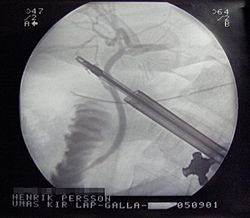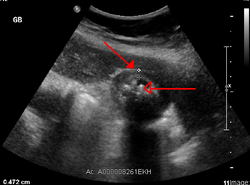Cholecystitis
Cholecystitis is when the gallbladder gets inflamed.[1] If it is not treated, cholecystitis can become life-threatening, such as if it results in one's gallbladder rupturing.[1] Treating cholecystitis often involves removing the gallbladder.[1]
Notable cases
After his assassination, U.S. President James A. Garfield might have had a case of cholecystitis that resulted in his condition becoming worse starting from late July 1881.[2] The reason for this might have been that President Garfield's doctors might have accidentally injured and created a hole in his bladder while they were searching his body for his assassin Charles Guiteau's bullet.[2]
Cholecystitis Media
Gallstones and biliary sludge, but the gallbladder wall is not clearly thickened, with no edema in the pericholecystic fat, thus not cholecystitis.
Significant gallbladder wall thickening
Gross examination of gallbladder carcinoma, with a prominent nodule.
References
- ↑ 1.0 1.1 1.2 "Cholecystitis - Symptoms and causes". Mayo Clinic.
- ↑ 2.0 2.1 Pappas, Theodore N.; Joharifard, Shahrzad (1 October 2013). "Did James A. Garfield die of cholecystitis? Revisiting the autopsy of the 20th president of the United States". The American Journal of Surgery. 206 (4): 613–618. doi:10.1016/j.amjsurg.2013.02.007. PMID 23827513 – via www.americanjournalofsurgery.com.




